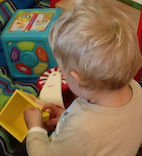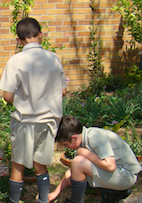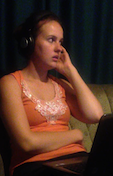Exercises for the brain, in the classroom - exploring neurobics
Neurobics encourages us to use as many senses as possible to create strong and multiple associations, therefore when we remember the information there are more links. When we need to recall the information we have many associations to draw on and therefore better memory recall.

Think of how a baby learns, using all his or her senses. When exploring a new toy or item, they will look at it, touch it, move it, smell it and taste it, making many associations and therefor strong connections.
When older person or adult sees that toy or item, it will recognised easily, due to the many associations that can be used to recall the information.
Carol Leaf (Switch on your Brain) says our mind is designed to control our body, and our brain is part of our body. Our brains are changing moment by moment, as we are thinking and making decisions. We are constantly reacting to the experiences we are exposed to, this in turn forms our brains and minds, either positively or negatively.
In modern life we get into routines and life is very predictable; we go to the same shop, amenities such as water is accessible from taps within our homes, we travel the same route to work. All these activities don't stimulate the brain, according to Lawrence Katz and Manning Rubin, in "Keep your Brain Alive". These routine activities could deaden the brain. So how do we in the modern world keep our brain stimulated and "alive"?
Your brain is a working, thinking organ, it continually learns and grows by interacting with the world around it, through action, association and perception. Mental stimulation and physical exercise, improves brain function and protects against cognitive decline.
Not every novel change stimulates the brain to make new neuronal connections, for example if you change from writing in pen to pencil, the changes are slight and won't be mentally stimulating.

However if you decide to write with a different hand the changes are vast, would be novel, challenging and even frustrating, using different areas of the brain to those usually used when writing. This would be a neurobic type exercise.
Neurobics in many instances gets us to rely less on our senses of sight and hearing which are used most often when learning at school, and to use the senses we use less frequently, namely: smell, touch and taste.
So what makes an exercise neurobic, according to Katz and Rubin?
1. Use one or more senses in a novel context
2. Engage or interact your attention - Engage in an activity that is fun, unusual, surprising.
3. Break a routine in a nontrivial, unexpected way
Don't use neurobic exercises all day in everything you do in the classroom. Choose one or two ideas that would interest and benefit the learners. Learners should still be encouraged to do a variety of activities to stimulate their brains, such as crossword puzzles, soduko, other puzzles, reading, learning new languages, engaging with others and / or learning to play a music instrument.
So what can we do in class to assist learners in being aware of neurobic exercises and teaching them to use as many associations as possible while learning?
When teaching use a variety of teaching aids, to develop as many varied sensory associations as possible.
In Pre-School and Foundation Phase many of the fun, novel and unusual teaching and learning ideas are included, as we progress up the schooling ladder teachers often use less and less sensory experiences as part of learning. As teachers of older learners we need to incorporate and think of ideas we could use to encourage these students to use senses, other than auditory and visual, as those are dominantly used in schooling.
Tell learners about neurobics and how it works. Ask them to think of ways they could do things differently.

For example: when washing hands in the bathroom, to do so with closed eyes. Trying to find the taps, the soap, washing and drying hands with eyes closed, engages and stimulates other senses.
Perhaps when going to break, getting a friend to lead another friend to the play area, with closed eyes. Or when moving from one class to another, a teacher could get half class to lead the other half whose eyes are closed. This type of activity breaks the routine of how learners walk to fields at break time or from class to class, it is novel and the reliance is on other sensors. Make learners aware of the responsibility to protect each other when being the leader, and not leading each other into dangerous or harmful situations. This type of activity also builds trust between learners.
Use as many resources that stimulate various sensors when teaching, so learners can make many different associations when learning, therefore when having to recall the information learners have many associations to draw on.
Possible ideas - try presenting some of these ideas during your lessons
School activity: Create a tactile and sensory garden at school, this is a pathway which

has a rope or structure of some sorts to guide you as you walk through it. Plant various herbs and plants that the learners can touch, smell and feel as they move along the path. Other textural items might also be added along the way, such as rough and smooth items. Learners should be encouraged to move through the space, using other senses rather than their eyes with their eyes closed.
Class activity: Teachers could have smaller versions of a textural experience in the classroom, with a nature table or experiential table, where learners need to identify items by smell and touch, associating them with other objects or items.
Class activity: Tactile, feelly bag activity. Place items in a black bag, learners should feel the objects to identify them. An extension of this activity, would be to give the children a glove to wear while they are trying to identify the objects or another might be asking children to use their less dominant hand when trying to identify the items.
School activity: Create an olfactory route map around the school, place spray canisters in different areas around the school. Encourage learners to spray the fragrance as they move past the space. The brain will develop an association with that fragrance in that space of the school. Spray bottles with a few drops of essential oil (cedarwood, orange, peppermint and / or rose oils) could be placed in containers around the school, for learners to spray and smell.
School activity: Ongoing chess game, set up a chess game in a school common area or outside in a quad. The rule would be that a learner may only do a single move in a school day, encouraging as many learners as possible to play. A device or token could be placed next to the board identifying which colour's turn it is to move.
Class activity: Pairing olfactory sense with hearing, learners could be asked to create a presentation of pairing a type of music with a fragrance, and sharing their ideas with other learners. Perhaps explaining why they chose that association.
Class activity: Tell learners to rearrange the items in spacecase or stationery holder, or reorder the way they have placed their items on the desk in the classroom. The routine is broken, having to remember and look for the items in a different space.
Class activity: Colour of light - Buy different colours of cellophane, cover the lights in a reading or individual working area with a colour, or allow learners to change the colours themselves. Ask them to discuss the experience of reading or working under different coloured light.
Class activity: Learn Braille, get learners to learn how to read Braille, using touch to engage and interact. Braille and written instructions could be included in the tactile garden as well.
Class activity: Brainstorming is a neurobic activity, where small groups of learners work with others, sharing many ideas, making associations from each other's different ideas, without judgement and criticism. Arthur B van Gundy suggests that when brainstorming, the ideas may be as creative and unusual as the participant wishes, others should embellish or hitch-hike on those ideas, building on them. Eventually dividing the ideas into different groups or categories. Then deciding which of the ideas might solve the group's problem, and finally presenting the idea or ideas to the other groups.
Class activity: Creative problem solving is another idea, for example take an every day item and ask learners to think of other possible uses for that item, other than what it has been made for. Get the earners to think of as many ideas as possible. Possible items, to begin with, may be a paper-clip or a pen.
Class activity: Solve problem - If teaching structures, give the learners a single sheet of A4 paper and ask them to create the tallest freestanding possible structure, using only the piece of paper.
Class activity: Hang posters or information upside down on occasion. By hanging the item upside down the visual processing of the image is alerted. Visual information is interpreted in two ways by the brain, the analytical or left handside of the brain, tries to identify and label the object at a glance, such as a table, chair, etc. The right side identifies or perceives spatial relations and nonverbal cues. When a picture is upside-down the right side of the brain kicks in, as it tries to interpret the colours, shapes and relationships of components to form the image. Betty Edwards in "Drawing on the right side of the brain" says this type of activity stimulates and awakens the individual's latent artistic interest or awareness. This type of activity is novel and visually stimulating.
Class activity: Identifying objects by feel, place various items in an open container, try to identify the items by feel, as you walk past. Items such as paper-clips, split pins, screws, small pebbles and beads,
Class activity: Play natural environmental sounds / music to stimulate auditory awareness while doing a written or mathematical task, such as the sea and waves, wind blowing in trees or bird calls. Example of natural sounds - birds chirping http://youtu.be/rnmx7svGb-o
School and / or class activity: Create a treasure hunt around the school for learners to find various items of different textures or shapes. Learners could record the information by taking photographs using their cellphones. The treasure hunt could also be a series of QR codes, which gives the learners the clues they need to follow, using visual indicators, or even using audio recordings.
Class activity: Use taste buds while blocking your nose, get learners to try to identify sweet, sour, bitter and salty items, while holding their noses closed.
Class activity: Association and remembering, bring fruits or vegetables, get learners to taste the items without seeing them, and describing where they remember eating the item for the first time or describing some association with the taste or flavour.
Class activity: Create a collaborative mural on a piece of paper, in a group of 4 - 6 learners, creating the same image or idea, all working on the same idea and on the same piece of paper.
Class activity: Foot-work - Create a drawing or painting, by using your foot to hold the crayon or paint brush.

Class activity: Know your instruments - Play a piece of music, listen carefully and try to identify the instrument/s being used
Class activity: Smell and tell, have different items, smell them one at a time, and try to identify what the smell is.
You should not try to include neurobic activities throughout the lesson, one or two would be affective, include a variety of activities that keep learners engaged, interested and stimulated.
Using neurobic type activities helps learners to build associations, so that when they are having to recall information during an assessment, the brain has various associations to draw on, which would assist in knowledge recall. This type of teaching benefits learners as the different learning styles and the multiple intelligences of individual's are engaged in these lessons.
Think of one idea at a time to include in your lessons, see how learners react, enjoy the positive reaction of the learners. Slowly develop a series of neurobic activities to include in your different lessons. Have fun in the process!
References
Jensen, E. (2005) Teaching with the Brain in Mind. 2nd edition. ASCD.
Lawrence Katz and Manning Rubin (1999) Keep Your Brain Alive, 83 Neurobic Exercises, to help prevent memory loss and increase memory fitness. Workman Publishing Company. New York.
Leaf, C. (2013) Switch on your Brain. Featuring the 21day brain detox plan. The peak way to happiness, thinking and health. Baker Books. Michigan.
Sousa, D. A (Ed.) (2010) Brain, Mind, Education. Neuroscience Implications for the Classroom. Solution Tree Press. Bloomington, IN, USA
Let me know if you enjoyed this information, leave a comment. If you would like me to do workshops with your staff, contact me on the Contact page.
I would love to hear your thoughts and ideas, email me on: karen@walstra.co.za
or comment about the article on the blog comment.
Follow me on Twitter at @KarenWalstra






